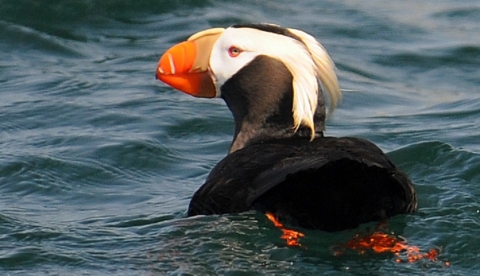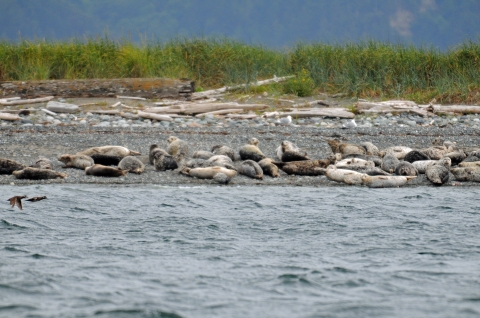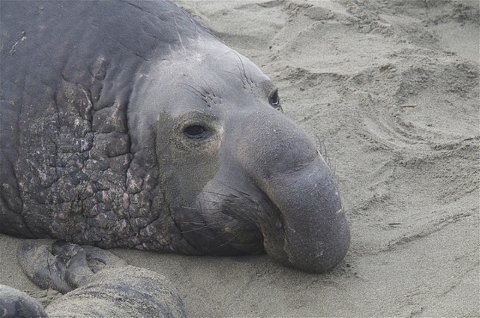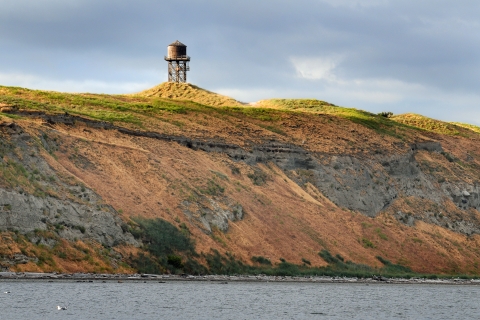Featured Species
Situated just off shore of the Olympic Peninsula in the Strait of Juan de Fuca, Protection Island is home to a great variety of wildlife. Here are just a few of the many species of birds and mammals that rely on the Island for survival.
Birds
Seabirds spend most of their time on the ocean and return to land only to reproduce and raise their young. There are six species of seabirds that commonly nest on the refuge. They are the rhinoceros auklet, tufted puffin, pigeon guillemot, glaucous-winged gull, and double-crested and pelagic cormorants.
Seabirds of the Pacific Northwest
Rhinoceros Auklet
During breeding season a distinctive "horn" on a bright orange beak makes the rhinoceros auklet a very recognizable bird. The sandy bluffs of Protection Island provide the ideal habitat in which the auklets create their nest burrows. The surrounding waters provide fertile fishing grounds where these crepuscular hunters gorge themselves on sandlance and herring. As one of only eight islands in North America where rhinoceros auklets breed, Protection Island is very important to the survival of this species.
Pigeon Guillemot
The pigeon guillemot is a small black seabird with a white wing patch and bright orange feet. They are one of Washington's most widespread seabirds. They aren't picky when it comes to nesting and will build their nests in driftwood, grassy areas, or burrows in dirt cliffs. The Refuge provides a wide variety of these habitats from which they may choose.
Tufted Puffin
The tufted puffin is distinguished by its bulbous orange beak, white face mask, blonde forehead plumes, and black body. The sandy soils of Protection Island provide ample room for excavating nesting burrows where puffin parents tend to just one egg. Unlike rhinoceros auklets, tufted puffins search for fish during the day, returning to their burrow to feed the lone nestling until it fledges.
Glaucous-winged Gull
Glaucous-winged gulls are among the largest gull species. These gulls are characterized by a white head, chest and tail with a gray back and wings; along with a yellow beak and pink legs. Protection Island is home to the largest glaucous-winged gull colony in the Salish Sea. The gulls hide their nests in the divots and hillocks on the island to evade predation by bald eagles.
Great Horned Owl
Found throughout North America and much of South America, Great Horned Owls are aggressive and powerful hunters earning them the nickname “tiger owl”. These large owls begin nesting very early in the north, and their deep hoots may be heard rolling across the Island on mid-winter nights.
Mammals
The quiet shorelines, upland forests, and grassy fields of Protection Island provide ideal habitats for a variety of land and marine mammals.
Harbor Seal
The Salish Sea supports a healthy population of harbor seals. They can be identified by their gray to brown, spotted skin. Although much of their life is spent in the water, harbor seals periodically "haul out" on land to rest, molt, give birth, and care for pups. Hundreds of seals use the shores of Protection Island for this purpose. They are present year-round, but haul out on the island most frequently during their summer and fall pupping and molting seasons.
Northern Elephant Seal
Although much more rarely seen than harbor seals, elephant seals also populate the island's shore. Larger than harbor seals, male elephant seals are easily identified by their large, elephantine nose. They use the beach to mate, birth pups, and molt. Because they lose all their hair at one time in a surprisingly bloody process, the elephant seal's molt is referred to as a "catastrophic molt."
Columbia Black-tailed Deer
The Columbia black-tailed deer is a subspecies of mule deer native to the temperate forests of the coastal Pacific Northwest. The black-tailed deer are generally smaller than mule deer and have a tail completely covered in dark hair.
Townsend's Chipmunk
Named after John Kirk Townsend, an early 19th-century ornithologist, Townsend's chipmunks live in the forests of the Pacific Northwest and are in the squirrel family, Sciuridae. They spend most of their day searching for and stockpiling food.
Habitat
In one of the earliest written records of Protection Island, Captain George Vancouver described the landscape "as enchantingly beautiful as any of the most elegantly finished pleasure grounds in Europe." In subsequent years habitats on the island were tilled to plant crops, over grazed by livestock, used for bombing practice by the Navy and bulldozed to create hundreds of home sites for a large subdivision. Since designation as a National Wildlife Refuge in 1982, the island has been in recovery. As habitats slowly regenerate, Refuge staff work to repair the damage.
Shoreline
Protection Island is ringed by a shoreline of sand and gravel with driftwood in a tangled spine at the high tide line. At the west and east ends of the island Kanem and Violet Point Spits are formed by soil eroding down from the high bluffs and carried into place by longshore currents. The shoreline provides important breeding areas for birds such as pigeon guillemots who nest in the jumbled driftwood and black oystercatchers who make imperceptible nests from shells and pebbles.
Sandy Bluff
The bluffs surrounding the island are prime habitat for breeding rhinoceros auklets and tufted puffins. Hundreds of the birds' burrows riddle the face of the bluffs. The bluffs are composed of glacial deposits that are periodically eroded by wave action at the base, creating unstable conditions above. In the past, this erosion was exacerbated by overgrazing and the introduction of non-native plants. The removal of grazing animals and the restoration of native plant communities to the island will help to renew the natural rate of erosion, stabilizing this important habitat for the birds.
Grassland
The island was once topped with a luxurious prairie of native grasses and flowers. Today a few native plants survive on a plateau dominated by exotic grasses. Efforts to restore the grassland to its original glory are currently underway. Many species will benefit from the prairie restoration including golden paintbrush, camas, savanna sparrow, and northern harrier.
Forest
A small Douglas-fir forest provides a natural windbreak along the northern edge of the Island's upper plateau. The forest provides important habitat for bald eagles who breed on the island. Woodpeckers and great horned owls can also be found in the forest.

















